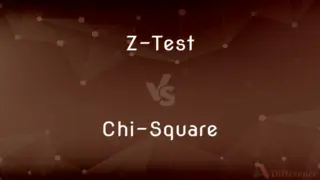Primary Immune Response vs. Secondary Immune Response — What's the Difference?
Edited by Tayyaba Rehman — By Fiza Rafique — Published on December 23, 2023
The Primary Immune Response is the body's initial reaction to a foreign invader, while the Secondary Immune Response is a faster, stronger reaction upon subsequent exposure to the same invader.

Difference Between Primary Immune Response and Secondary Immune Response
Table of Contents
ADVERTISEMENT
Key Differences
The Primary Immune Response occurs when the immune system encounters a pathogen for the first time. This response is characterized by a delay, as the system mobilizes to recognize and fight the invader. In contrast, the Secondary Immune Response is elicited upon subsequent exposures to the same pathogen, where the system responds more swiftly and robustly.
Production of specific antibodies is a hallmark of the Primary Immune Response. This initial reaction might take days to become effective, as the immune system tailors its attack. The Secondary Immune Response, however, capitalizes on the memory from the primary response, rapidly producing a large amount of specific antibodies.
The Primary Immune Response involves the activation of immune cells called naïve B cells, which then differentiate into memory B cells after the threat is neutralized. When encountering the same pathogen later, these memory cells instigate the Secondary Immune Response, ensuring a quicker and more potent reaction.
Immunizations exploit the difference between the Primary Immune Response and Secondary Immune Response. Vaccines often introduce a harmless version of a pathogen to elicit a primary response, so that upon real exposure, the secondary response is immediate and effective.
Long-lasting immunity is a benefit of the Secondary Immune Response. After the Primary Immune Response has been triggered and memory cells are in place, the body is better equipped to combat the same pathogen if exposed again in the future.
ADVERTISEMENT
Comparison Chart
Time to Initiation
Delayed, as the system recognizes and tailors its response.
Rapid, due to memory from the primary response.
Antibody Production
Gradual increase over days.
Rapid and large-scale production.
Involved Cells
Naïve B cells initially activated.
Memory B cells from primary exposure lead the response.
Strength of Response
Milder and may take days to become effective.
More potent and immediate.
Duration of Effectiveness
Short-lived immunity.
Long-lasting immunity due to memory cells.
Compare with Definitions
Primary Immune Response
A process where naïve B cells are activated upon first exposure to a foreign agent.
The vaccine aimed to stimulate a Primary Immune Response without causing disease.
Secondary Immune Response
The phase of immunity providing long-lasting protection against familiar threats.
Her swift recovery showcased the efficiency of the Secondary Immune Response.
Primary Immune Response
The initial immune reaction to a never-before-encountered pathogen.
The patient's Primary Immune Response took several days to fight off the new virus.
Secondary Immune Response
The body's quick and potent reaction upon re-exposure to a known pathogen.
Thanks to her vaccination, her Secondary Immune Response quickly neutralized the virus upon exposure.
Primary Immune Response
The slower, adaptive immune response to a new invader.
Understanding the Primary Immune Response is key to developing effective vaccines.
Secondary Immune Response
A heightened defense mechanism activated by memory B cells.
The vaccine's effectiveness was evident in the robust Secondary Immune Response of patients.
Primary Immune Response
The first line of defense against a new antigenic challenge.
Her Primary Immune Response was still ramping up, so she felt ill for a few days.
Secondary Immune Response
The subsequent immune response to a previously encountered antigen.
Booster shots ensure a strong Secondary Immune Response if exposed to the disease.
Primary Immune Response
The stage where the immune system tailors its attack against a novel threat.
Researchers studied how various pathogens influenced the Primary Immune Response.
Secondary Immune Response
The rapid immune reaction based on memory from a prior exposure.
His Secondary Immune Response was evidence that he had encountered the pathogen before.
Common Curiosities
Are vaccines related to these responses?
Yes, vaccines aim to elicit a Primary Immune Response to prepare for a swift Secondary Immune Response upon real exposure.
Why is the Secondary Immune Response faster?
It capitalizes on memory cells formed during the Primary Immune Response.
Is the Secondary Immune Response always guaranteed after a Primary Immune Response?
Typically, yes, but its efficiency can vary based on factors like time since first exposure.
Which response leads to long-lasting immunity?
The Secondary Immune Response provides longer-lasting immunity.
How do memory cells aid the Secondary Immune Response?
Memory cells from the Primary Immune Response recognize the pathogen and initiate a rapid, potent response.
Can the Primary Immune Response always fend off pathogens?
It may take longer and might not be as effective as the subsequent Secondary Immune Response.
How can one enhance the Secondary Immune Response?
Regular vaccinations and booster shots can help strengthen the Secondary Immune Response.
Are antibody levels different between the two responses?
Yes, the Secondary Immune Response produces antibodies more rapidly and in larger quantities.
Do booster shots relate to these responses?
Yes, boosters reinforce the Secondary Immune Response to certain pathogens.
What triggers the Primary Immune Response?
It's triggered upon the first encounter with a specific pathogen.
Which cells are central to the Primary Immune Response?
Naïve B cells are pivotal during the Primary Immune Response.
Why is the Primary Immune Response slower?
It involves the recognition and tailoring of defense mechanisms to a new threat.
Share Your Discovery

Previous Comparison
Z-Test vs. Chi-Square
Next Comparison
Primary Evidence vs. Secondary EvidenceAuthor Spotlight
Written by
Fiza RafiqueFiza Rafique is a skilled content writer at AskDifference.com, where she meticulously refines and enhances written pieces. Drawing from her vast editorial expertise, Fiza ensures clarity, accuracy, and precision in every article. Passionate about language, she continually seeks to elevate the quality of content for readers worldwide.
Edited by
Tayyaba RehmanTayyaba Rehman is a distinguished writer, currently serving as a primary contributor to askdifference.com. As a researcher in semantics and etymology, Tayyaba's passion for the complexity of languages and their distinctions has found a perfect home on the platform. Tayyaba delves into the intricacies of language, distinguishing between commonly confused words and phrases, thereby providing clarity for readers worldwide.














































